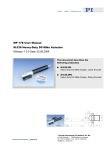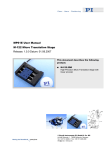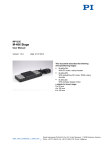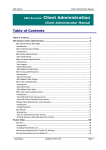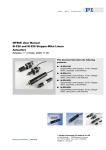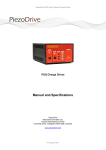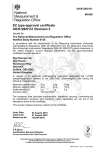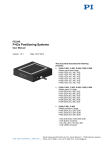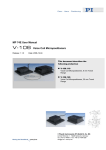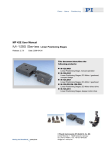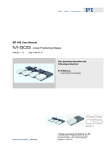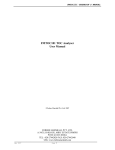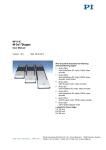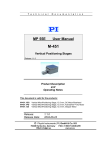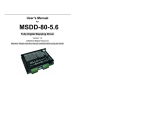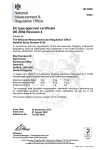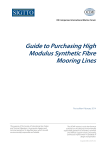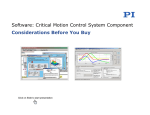Download User Manual MP73E - Physik Instrumente
Transcript
MP 73E User Manual M-403Linear Translation Stages Release: 2.0.1 Date: 25.04.2007 This document describes the following product(s): ■ M-403.xDG Linear Translation Stage, DC-Motor ■ M-403.xPD Linear Translation Stage, ActiveDrive™ ■ M-403.x2S Linear Translation Stage, Stepper Motor © Physik Instrumente (PI) GmbH & Co. KG Auf der Römerstr. 1 ⋅ 76228 Karlsruhe, Germany Tel. +49 721 4846-0 ⋅ Fax: +49 721 4846-299 [email protected] ⋅ www.pi.ws Physik Instrumente (PI) GmbH & Co. KG is the owner of the following company names and trademarks: PI®, ActiveDrive™, Mercury™, Mercury™ Step The following designations are protected company names or registered trademarks of third parties: Windows Copyright 1999–2007 by Physik Instrumente (PI) GmbH & Co. KG, Karlsruhe, Germany. The text, photographs and drawings in this manual enjoy copyright protection. With regard thereto, Physik Instrumente (PI) GmbH & Co. KG reserves all rights. Use of said text, photographs and drawings is permitted only in part and only upon citation of the source. First printing 25.04.2007 Document Number MP 73E BSc, Release 2.0.1 M-403_User_MP73E_201.doc Subject to change without notice. This manual is superseded by any new release. The newest release is available for download at www.pi.ws (http://www.pi.ws) About This Document Users of This Manual This manual is designed to help the reader to install and operate the M-403 Linear positioning stage. It assumes that the reader has a fundamental understanding of basic servo systems, as well as motion control concepts and applicable safety procedures. The manual describes the physical specifications and dimensions of the M-403 Linear positioning stage as well as the procedures which are required to put the associated motion system into operation. Conventions The notes and symbols used in this manual have the following meanings: WARNING Calls attention to a procedure, practice or condition which, if not correctly performed or adhered to, could result in injury or death. ! CAUTION Calls attention to a procedure, practice, or condition which, if not correctly performed or adhered to, could result in damage to equipment. NOTE Provides additional information or application hints. The motion controller and the software tools which might be mentioned in this documentation are described in their own manuals. All documents are available as PDF files via download from the PI Website (www.pi.ws (http://www.pi.ws)) or on a product CD. For updated releases contact your Physik Instrumente sales engineer or write [email protected] (mailto:[email protected]). Contents 1 Introduction 1.1 1.2 1.3 1.4 1.5 1.6 2 3 9 Mechanical Mounting .......................................................................... 9 Moving the Stage .............................................................................. 11 Operational Considerations 3.1 3.2 3.3 3.4 3.5 3.6 4 Product Description............................................................................. 3 Prescribed Use.................................................................................... 4 Safety Instructions............................................................................... 5 Model Survey ...................................................................................... 6 Unpacking ........................................................................................... 7 Additional Components ....................................................................... 7 Start-Up 2.1 2.2 13 PWM Amplifiers................................................................................. 13 Limit Switches ................................................................................... 13 Reference Switch .............................................................................. 14 Rotary Encoder ................................................................................. 14 Motor Controllers............................................................................... 14 Host PC............................................................................................. 14 Troubleshooting 4.1 4.2 3 16 Diagnosis .......................................................................................... 16 Customer Service.............................................................................. 18 5 Maintenance 19 6 Technical Data 20 6.1 6.2 6.3 Specifications .................................................................................... 20 Range and Transmission Ratio Values............................................. 22 Dimensions ....................................................................................... 22 6.3.1 6.3.2 6.4 M-403.xxx ........................................................................................... 23 Accessory Adapter Plates .................................................................. 24 Pin Assignments ............................................................................... 27 6.4.1 6.4.2 Analog DC-Motor Versions................................................................. 27 DC-Motor ActiveDrive™ (PWM) ......................................................... 28 6.4.3 7 2-Phase Stepper Motor ...................................................................... 28 Appendix 7.1 7.2 29 Related Products............................................................................... 29 Motor Controller Details .................................................................... 30 7.2.1 7.2.2 Stepper motor controllers ................................................................... 30 DC Motor Controllers.......................................................................... 30 8 Glossary of Terms 33 9 Index 37 Introduction 1 Introduction 1.1 Product Description Figure 1: Different motor versions of the M-403 linear stage family with 100 mm travel range (from left): M-403.4PD (DC-motor/Active Drive(TM)), M-403.4DG (DC-motor/gearhead) and M-403.42S (stepper motor) The optimum choice of high-value, low-cost components makes the M-403 family of linear stages very attractive and economical. These stages are leadscrew-driven and provide a minimum incremental motion to 0.2 µm. The precision-machined, high-density, stress-relieved aluminum base provides exceptional stability with minimum weight. M-403 are available in 5 lengths providing travel ranges from 25 to 200 mm. High-Load and Maintenance-Free All models are equipped with high-precision linear guiding rails and recirculating ball bearings. The recirculating ball bearings are maintenance free and immune to cage migration. The choice of components and careful mounting guarantees high load capacity, longer lifetime and high guiding accuracy. The stages can carry up to 20 kg and push/pull up to 50 N. Three Motor Drive Options M-403.xPD versions feature the high-performance ActiveDrive™ system. The ActiveDrive™ design, developed by PI, features a high-efficiency PWM (pulse width modulation) servo-amplifier mounted side-by-side with the DC motor and offers several advantages: ■ www.pi.ws Increased efficiency, by eliminating power losses between the amplifier and motor M-403 MP 73E Release 2.0.1 Page 3 Introduction ■ Reduced cost of ownership and improved reliability, because no external driver is required ■ Elimination of PWM amplifier noise radiation, by mounting the amplifier and motor together in a single, electrically shielded case M-403.xDG models are equipped with a DC motor and a shaft-mounted optical encoder, providing a minimum incremental motion of 0.2 µm. M-403.x2S models feature a direct-drive, 2-phase stepper motor, providing very smooth operation and a resolution of 0.1 µm per step. Limit and Reference Switches For the protection of your equipment, non-contact Hall-effect limit and reference switches are installed. The direction-sensing reference switch supports advanced automation applications with high precision. The M-403 / M-413 and M-404 / M-414 series of linear stages form a modular system. The M-403 is the basic family, providing travel ranges from 25 to 200 mm. M-413 is designed for higher loads with travel ranges from 100 to 300 mm. The M-404 and M-414 stages have the same travel ranges and load capacities, but offer higher precision and more speed.. 1.2 Prescribed Use Correct operation of the M-403 positioners is only possible in combination with a suitable controller/driver (ordered separately) and software. The controlling device must be able to read out and process the signals from reference and limit switches and the incremental position encoder to ensure proper performance of the servo-control system. Based on their design and realization, the M-403 stages are intended for single-axis positioning, adjusting and shifting of loads at various velocities. M-403 positioners can be mounted horizontically or vertically. To achieve the specified guiding accuracy, the positioners have to be mounted on a flat surface to avoid torsion of the basic profile. The positioners may only be used for applications suitably in accordance with the device specifications. Respect the safety instructions given in this User Manual. The operator is responsible for the correct installation and operation of the M-403. www.pi.ws M-403 MP 73E Release 2.0.1 Page 4 Introduction The verification of the technical specifications by the manufacturer does not imply the validation of complete applications. In fact the operator is responsible for the process validation and the appropriate releases. The M-403 meets the specifications as defined by DIN EN 61010 for safe operation under normal ambient conditions. See the specifications table for details. 1.3 Safety Instructions CAUTION Read this before operating the equipment covered in this manual. Always keep the User Manual safe and close to the described device. In case of loss or damage to the instructions, please order a new copy from your PI distributor or download one from www.pi.ws (http://www.pi.ws). Also keep and add all further information (e.g. extended instructions or Technical Notes) to the User Manual. ! Read carefully the User Manuals of all other components involved such as controllers or software. Read the following before operating the equipment covered in this manual: WARNING—CRUSH HAZARD Never put anything where the moving platform or any connected object could possibly trap it! The moving platform can accelerate rapidly and generate high forces which can cause damage or injury. CAUTION Be aware that the stage could start an unexpected move when first connected to the motor controller. Be aware that failure of the motor controller may crash the stage against a hard stop. Crashes can cause irreparable damage. Do not disable limit switches in software. Test limit switch operation at low speeds. Stop system if necessary. Do not let it run against a hard stop. www.pi.ws M-403 MP 73E Release 2.0.1 Page 5 ! Introduction 1.4 Model Survey A total of 15 M-403 standard versions is available. They differ in terms of drive types and travel ranges. The drive type and the travel range are encoded in the model number. The drive section options are shown in the table below. The “x” in the model number stands for the travel range code. Models M-403.xDG M-403.xPD M-403.x2S Drive type DC-Motor, gearhead, 2.5 W DC- Motor, ActiveDrive™, 26 W 2-phase-stepper motor Yes No Yes Yes Yes Yes Position Yes encoder Limit switch Yes Direction-sensi Yes ng reference switch The travel range differences and their encoding in the model number are as follows (here the “xx” in the model number stands for the drive-type code): www.pi.ws Models M-403.1xx M-403.2xx M-403.4xx M-403.6xx M-403.8xx Travel range in mm 25 50 100 150 200 M-403 MP 73E Release 2.0.1 Page 6 Introduction Figure 2: M-403 linear stage versions (from left): M-403.1PD, M-403.2PD, M-403.4PD, M-403.6PD and M-403.8PD provide travel ranges from 25 to 200 mm 1.5 Unpacking Unpack the M-403 Linear positioning stage with care. Compare the contents against the items covered by the contract and against the packing list. The following components are included: ■ M-403 Linear Translation Stage ■ C-815.38 motor cable for connecting to motor controller ■ Screw set with 6 M4 x 30 and 4 M6 x 2 screws for mounting ■ User manual for M-403 (this document) in printed form ■ M-403.xPD only: M-500.PS power supply with line cord Inspect the contents for signs of damage. If parts are missing or you notice signs of damage, contact PI immediately. Save all packing materials in case the product need be shipped again. 1.6 Additional Components Depending on your application, you might need the following accessories (p. 23) for use with the M-403 Linear Positioning Stage : ■ M-403.AP1: Adapter plate for mounting stages with PI standard hole pattern on M-403 stages, www.pi.ws M-403 MP 73E Release 2.0.1 Page 7 Introduction ■ M-403.AP2: Z-axis adapter plate for vertical mount of M-403 stages on M-403 stages, ■ M-403.AP3: Universal adapter plate for mounting M-403 stages on stages with PI standard hole pattern. Contact your PI sales engineer or write [email protected] if you need additional components. www.pi.ws M-403 MP 73E Release 2.0.1 Page 8 Start-Up 2 Start-Up 2.1 Mechanical Mounting NOTE If the counter-sunk mounting holes in the stage base are covered by the platform, you must first move the platform to a position which allows access. Read "Moving the Stage (p. 11)" for instructions. Figure 3: M-ounting hole locations on stage, identical for all models To mount an M-403 stage on a base plane, use the two holes for M6 screws or the four counter sunk holes for M4 screws in the stage base and the corresponding mounting screws which come with the stage. The arrangement of the M6 holes complies with the 25 mm-hole pattern of standard metric honeycomb tables. You have best access to the M6 mounting holes, when the platform is at its central reference switch (for reaching the reference position see the User Manual of the motor controller used). www.pi.ws M-403 MP 73E Release 2.0.1 Page 9 Start-Up You can assemble stacked XY- or XYZ-systems with M-403 stages. For mounting, use the M4 x 30 screws which come with the stages: ■ For an XY-system, use the four counter-sunk holes for M4 in the base of the upper M-403 stage and the four M4 threaded holes in the moving platform of the lower M-403 stage (see Fig. above). ■ For Z-axis mounting, the M-403.AP2 Z-axis adapter plate is required. First mount this plate on the front of the Z-axis stage using the two M4 threaded holes in the stage base (see Fig. above). Then affix the adapter plate to the moving platform of the lower M-403 stage (see Fig. below). Figure 4: Z-axis mounting To mount a stage with PI standard hole pattern on an M-403 stage, the M-403.AP1 adapter plate is required. To mount a M-403 stage upon a stage with PI standard hole pattern, the M-403.AP3 adapter plate is required. www.pi.ws M-403 MP 73E Release 2.0.1 Page 10 Start-Up 2.2 Moving the Stage WARNING—CRUSH HAZARD Never put anything where the moving platform or any connected object could possibly trap it! The moving platform can accelerate rapidly and generate high forces which can cause damage or injury. NOTE The positive direction of motion is away from the end where the motor is mounted. Figure 5: M-4xx stage unit, arrow indicates positive direction of motion Prior to operation, you should read the documentation for your motor controller. If using any PWM stages read the section about PWM amplifiers (p. 13) carefully. To operate a stage, proceed as follows: 1 www.pi.ws Install/connect the controller following the instructions in the controller manual. If you are going to use a host computer, install the M-403 MP 73E Release 2.0.1 Page 11 Start-Up host software in the host computer. This procedure is described in the controller User Manual and/or associated software manuals. 2 Connect the stage to the controller using the connecting cable (part number C-815.38), which comes with the stage. With multi-axis controllers, be sure to note the axis designation of the connection selected. 3 M-403 versions with ActiveDrive™ (PWM) only: Connect the stage to the M-500.PS power supply, which comes with the stage and connect the power supply to line power (wide range). To activate the M-500.PS power supply switch the "-/o"-button to position "-". 4 Command a few test moves to make sure everything is working properly. For best performance and system compatibility we recommend using PI controllers. Most PI controllers come with a graphic-user-interface-software which is easy to setup and allows quick installation and testing. NOTE Most standard controllers and / or software from PI use a DAT file which contains information on all standard micropositioners and installs automatically with the host software. This file, called pistages.dat, also includes an initial set of PID servo-control parameters for each stage type. If your system does not use pistages.dat, possible PID parameters are included in this manual. www.pi.ws M-403 MP 73E Release 2.0.1 Page 12 Operational Considerations 3 Operational Considerations 3.1 PWM Amplifiers The M-403.xPD stages feature a DC servo-motor with a high-efficiency PWM amplifier mounted side by side. This ActiveDrive™ system provides maximum dynamic performance. An external plug-in power supply (M-500.PS) is provided to supply the built-in amplifier. This architecture allows high torque and high velocities while loading the motor controller with control signals only. 3.2 Limit Switches All M-403 positioners are equipped with non-contact, Hall-effect limit switches (with TTL drivers). Each limit switch sends an overtravel signal on its own dedicated line to the controller. It is the controller that is then responsible for stopping the motion. If it does not do so in time, the positioner will run into the hard stop. On stepper-motor versions, limit switch outputs are active low, on other versions, active high. CAUTION Crashes can cause irreparable damage. Do not disable limit switches in software. Test limit switch operation at low speeds. Stop system if necessary. Do not let it run against a hard stop. Limit Switch Specifications: www.pi.ws Type: magnetic (Hall-effect) sensors Supply.voltage +5 V / GND, supplied by the motor controller through the motor connector. Signal output: TTL level Sink / Source capab. 20 mA at 18°C Signal logic (stepper motors) active low; normal operation: high, limit sensor reached: low Signal logic (DC-motors): active-high; normal motor operation: low, limit sensor reached: high M-403 MP 73E Release 2.0.1 Page 13 ! Operational Considerations 3.3 Reference Switch All stage versions are equipped with a direction-sensing Hall-effect reference switch, which is located at about the midpoint of the travel range. This sensor provides a TTL signal indicating whether the positioner is to the positive or negative side of a fixed point. The rising or falling edge of this signal can be used to indicate a known reference position within 0.5 µm accuracy (depending on the controller). The difference in the reference point when approached from the positive or the negative side is about 0.2 mm to 0.4 mm. See the controller User Manual and/or associated software manuals for the commands which make use of the reference signal. 3.4 Rotary Encoder M-403.xDG and M-403.xPD are equipped with DC motors with a shaft-mounted position encoder. It provides highly accurate signals whenever the position changes by a known, small amount. By monitoring the encoder pulses, called counts, the controller can keep track of the relative motion of the stage. To discover the absolute position, it is necessary to drive the stage to a limit or reference switch. Most controllers have commands to automate this procedure, which is called referencing. 3.5 Motor Controllers M-403-series micropositioners can be connected to the same motor controllers as other micropositioners from PI. DC motor controllers from PI can control both analog and ActiveDrive™ (PWM) motor versions. The required operating mode is set automatically—depending on the controller model, either directly when the controller is powered up, or when the user chooses the connected positioner type in the control software. If networking several positioners, you have to keep in mind that stepper motor devices can only be networked with other stepper-motor devices. This manual includes a list of suitable controllers. 3.6 Host PC Most controllers from PI are in turn controlled by a host PC provided by the user. The controller is either installed directly in the PC (e.g. C-843 PCI board) or connected to it over a communications interface. See the controller User Manual for details. www.pi.ws M-403 MP 73E Release 2.0.1 Page 14 Operational Considerations PI provides software and/or drivers that run on the host PC to control the system. Typically, there will be a control program with a graphic user interface for testing and simple operation, and, in addition, DLL, COM and/or LabView drivers for users who wish to use custom software. If the controller is a PC ISA or PCI card, there will also be hardware drivers to install. See the controller user and software manuals for installation details. www.pi.ws M-403 MP 73E Release 2.0.1 Page 15 Troubleshooting 4 Troubleshooting 4.1 Diagnosis Positioner does not move. Cables not connected properly: ■ Check the connecting cables. For positioners with ActiveDrive™ only: Check if power supply is connected: ■ Verify that the included MS-500.PS power supply is connected and turned on. Positioner or positioner cable is defective: ■ Replace positioner with a working positioner of the same type to test a new combination of controller and positioner (positioners of a different type may malfunction due to unsuitable parameter settings on the controller). Test cable and / or replace with a working cable of the syme type. Unusually high friction in the spindle-nut-system: ■ Clean the spindle and add new lubricant. Wrong command or wrong syntax: ■ Check the error code (with PI-GCS command set, use ERR?; see controller and software manuals for the error code explanations). Positioner is not referenced: ■ In the GCS command set, some closed-loop motion commands are not executed if the mechanics has not been referenced—(ERR? replies "5", see controller and software manuals). Reference the axis as described in the controller and user manuals. Wrong axis commanded: ■ Check if commanded axis is that of the desired positioner. www.pi.ws M-403 MP 73E Release 2.0.1 Page 16 Troubleshooting Incorrect configuration: ■ Check for anomalous parameter settings on the controller. Positioner starts to move but stops after a short time. Unusually high friction in the spindle-nut-system: ■ Clean the spindle and add new lubricant. Positioner does not reach position with expected accuracy. Motion parameters are not optimized: ■ Adjust the motion parameters according to the values given in this document. Positioner runs jerkily and not smooth enough. Motion parameters are not optimized: ■ Adjust the motion parameters according to the values listed in this document. Positioner did not stop in time and ran into a hard stop. The controller has not stopped the positioner in time: ■ Too high velocity. See chapter "Limit Switches". www.pi.ws ■ Turn off the motor. If possible, you may push the positioner out of the end zone manually. ■ The end of the leadscrew has an Allan wrench socket so it can be cranked manually. M-403 MP 73E Release 2.0.1 Page 17 Troubleshooting 4.2 Customer Service Still having problems? Call your PI representative or write to [email protected]; please have the following information about your system ready: www.pi.ws ■ Product codes and serial numbers of all products in the system ■ Current firmware version of the controller (if present) ■ Software version of drivers and / or host software (if present) ■ Operating system on host PC (if present) M-403 MP 73E Release 2.0.1 Page 18 Maintenance 5 Maintenance When operated in a clean environment, no maintenance is required. If the stages are operated in extremely dusty environments, we recommend cleaning and greasing the lead screw/ball screw and linear bearings from time to time. The time interval depends of the degree of contamination and can vary from 100 to 800 operating hours. www.pi.ws M-403 MP 73E Release 2.0.1 Page 19 Technical Data 6 Technical Data 6.1 Specifications Versions PD (ActiveDrive™) versions M-403.1PD / M-403.2PD M-403.4PD / M-403.6PD M-403.8PD DG (gearhead) versions M-403.1DG / M-403.2DG M-403.4DG / M-403.6DG M-403.8DG 2S (stepper) versions M-403.12S / M-403.22S M-403.42S / M-403.62S M-403.82S Units Tolerance Active Axes X X X Travel range 25 / 50 100 / 150 200 25 / 50 100 / 150 200 25 / 50 100 / 150 200 Integrated sensor Sensor resolution Design resolution Min. incremental motion Rotary encoder 4000 0.25 0.25 Rotary encoder 2000 0.018 0.2 — — 0.16 0.2 cts./rev. µm µm typ. typ. Backlash 6 10 6 µm typ. Unidirectional repeatability 1 1 1 µm typ. Pitch 200 200 200 µrad Yaw 200 200 200 µrad typ. over 100 mm typ. over 100 mm Max. velocity Origin repeatability 10# 1 2.5 1 3 1 mm/s µm 1 1 1 mm/U Motion and Positioning mm typ. Mechanical properties Spindle pitch www.pi.ws M-403 MP 73E Release 2.0.1 Page 20 Technical Data Gear ratio — 28.44444:1 / 3204:81 — Motor resolution Stiffness in motion direction — 3500 — 3500 6400* 3500 steps/rev. N/mm ± 20% Load Capacity** 200 200 200 N max. Push / pull force 50 50 50 N max. Lateral Force 100 100 100 N max. Drive type DC Motor, ActiveDrive™ DC motor, gearhead 2-phase stepper motor* Operating voltage 24 (PWM) 24 V Electrical power 26 0-12 differential, polarity determines direction 2.5 4.8 W -20 bis +65 Al (black anodized) 1.7 / 1.8 2.1 / 2.2 2.5 3 Sub-D 15 (m) C-843 PCI board, for up to 4 axes, C-862 single-axis -20 bis +65 Al (black anodized) 1.7 / 1.8 2.1 / 2.2 2.5 3 Sub-D 15 (m) C-843 PCI board, for up to 4 axes, C-862 single-axis -20 bis +65 Al (black anodized) 1.7 / 1.8 2.1 / 2.2 2.5 3 Sub-D 15 (m) C-663 single-axis °C Drive Properties nominal Miscellaneous Operating temperature range Material Mass Cable length Connector Recommended controller/driver kg ± 5% m ± 10 mm * ** 2-phase stepper motor, 24 V chopper voltage, max. 0.8 A/phase, 400 full steps/rev., motor resolution with C-663 stepper motor controller **Load: Max. normal load capacity: Centered, vertical load (horizontal installation of the stage). # Max. recommended velocity www.pi.ws M-403 MP 73E Release 2.0.1 Page 21 Technical Data 6.2 6.3 Range and Transmission Ratio Values M-403.1PD M-403.2PD Range [mm] 25 50 Range [cts] 100,000 200,000 M-403.4PD 100 400,000 M-403.6PD M-403.8PD 150 200 600,000 800,000 M-403.1DG M-403.2DG M-403.4DG M-403.6DG M-403.8DG 25 50 100 150 200 1,422,222 2,844,444 5,688,888 8,533,332 11,377,776 Transmission Ratio 4 cts/µm 56,88889 cts/µm Dimensions Dimensions in mm, decimal places separated by commas in drawings www.pi.ws M-403 MP 73E Release 2.0.1 Page 22 Technical Data 6.3.1 M-403.xxx Figure 6: M-403 www.pi.ws M-403 MP 73E Release 2.0.1 Page 23 Technical Data 6.3.2 Accessory Adapter Plates M-403.AP1 Adapter plate for mounting stages with PI standard hole pattern on M-403 stages Figure 7: M-403.AP1 adapter plate with PI standard hole pattern www.pi.ws M-403 MP 73E Release 2.0.1 Page 24 Technical Data M-403.AP2 Z-axis adapter plate for vertical mount of M-403 stages on M-403 stages Figure 8: M-403.AP2 Z-axis adapter plate www.pi.ws M-403 MP 73E Release 2.0.1 Page 25 Technical Data M-403.AP3 Universal adapter plate for mounting M-403 stages on stages with PI standard hole pattern Figure 9: Universal adapter plate www.pi.ws M-403 MP 73E Release 2.0.1 Page 26 Technical Data 6.4 Pin Assignments 6.4.1 Analog DC-Motor Versions Connector type on positioner: D-Sub15m Pin# Signal 1 9 2 10 3 11 4 12 5 13 6 14 7 15 8 Direction n.c. MOT (-) MOT (+) PGND n.c. n.c. +5V NLIM PLIM REFS GND A (+) A (-) B (+) B (-) input input input input output output output output output output output Function not connected motor connection (-)* motor connection (+)* ground (power) not connected not connected +5 V input for encoder and logic negative limit signal (active high), TTL positive limit signal (active high), TTL position reference signal, TTL ground (logic) encoder signal A, TTL encoder signal A-dash, TTL encoder signal B, TTL encoder signal B-dash, TTL * Polarity determines direction of motion: if MOT+ > MOT- motion is in the positive direction, i.e. away from the end where the motor is mounted. www.pi.ws M-403 MP 73E Release 2.0.1 Page 27 Technical Data 6.4.2 DC-Motor ActiveDrive™ (PWM) Connector type on positioner: D-Sub15m Pin# Signal Direction Function 1 ENABLE input Enable signal for power amplifier and motor brake, (+5 V to +12 V) 9 2 10 3 11 4 12 5 13 6 14 7 15 8 6.4.3 n.c. n.c. PGND MAGN SIGN +5V NLIM PLIM REFS GND A(+) A(-) B(+) B(-) input input input input output output output output output output output Not connected Not connected Ground (Power) PWM signal magnitude (speed) PWM signal sign (direction) +5 V input for encoder and logic Negative limit signal (active high), TTL Positive limit signal (active high), TTL Position reference signal, TTL Ground (logic) Encoder signal A, TTL Encoder signal A-dash, TTL Encoder signal B, TTL Encoder signal B-dash, TTL 2-Phase Stepper Motor Connector type on positioner: D-Sub15m Pin # 1 9 2 10 3 11 4 12 5 13 6 14 7 15 8 www.pi.ws Signal Direction Function phase 1a phase 1b input input motor winding 1a motor winding 1b phase 2a phase 2b n.c. n.c. n.c. n.c. n.c. input input motor winding 2a motor winding 2b not connected not connected not connected not connected not connected n.c. +5V PLIM GND REFS NLIM input output output output not connected +5V supply from controller positive limit signal (active low), TTL ground (power) reference signal, TTL negative limit signal (active low), TTL M-403 MP 73E Release 2.0.1 Page 28 Appendix 7 Appendix 7.1 Related Products With the M-403/M-413 linear stage series PI offers a flexible and cost-effective product line for cost-sensitive applications, The flexibility in travel range (25 to 300 mm) and motorization (stepper motors, gearbox and ActiveDrive™ direct-drive DC motors) provides a broad range of solutions for standard micropositioning tasks. For more-demanding applications, PI offers the M-404/M-414 stage series. Their outer dimensions and travel ranges are identical to the M-403/M-413, but due to the high-precision components used, they provide improved features such as: ■ More accurate guiding system by additional polishing of the bearing surface, ■ DC-motor with low-backlash gearhead, ■ Higher velocities and duty cycles due to the low friction of the ball screw, ■ Higher mechanical stability due to 2 polished mounting steps for low surface contact. Figure 10: M-403 to M-414 product portfolio. The M-403/M-413 series provide especially cost-effective micropositioning solutions. www.pi.ws M-403 MP 73E Release 2.0.1 Page 29 Appendix The smaller M-403 and M-404 provide a profile width of 80 mm and travel ranges of 25, 50, 100, 150 and 200 mm. The heavy-duty M-413 and M-414 provide a profile width of 120 mm and travel ranges of 100, 200 and 300 mm. 7.2 Motor Controller Details Each motorized stage in the motion system must be connected to a motion controller. The controller is either preprogrammed for stand-alone operation or networked with or installed in a PC: i.e. controller setup and/or operation are effectuated with software. 7.2.1 Stepper motor controllers The M-403 .x2S (stepper motor version) can be controlled with the C-663 Mercury™ Step stepper motor controller. PI stepper motors operate in open-loop mode. 7.2.2 Drive type Stepper Motor Controller Axes per controller Host PC interface Multiple controllers on same host PC C-663 Mercury™ Step 1 RS-232 bus or daisy chain yes, same port DC Motor Controllers M-403 DC-motor versions can be used with C-843 motor controller card or C-862 Mercury™ controller. Drive type DC Motor Controller Axes per controller C-862 Mercury™ 1 RS-232 bus or daisy chain Host PC interface Multiple controllers on yes, same or separate ports same host PC C-843 motor controller card 2 or 4 Internal (PCI bus) yes, separate slots NOTE Most standard controllers and / or software from PI use a DAT file which contains information on all standard micropositioners and installs www.pi.ws M-403 MP 73E Release 2.0.1 Page 30 Appendix automatically with the host software. This file, called pistages.dat, also includes an initial set of PID servo-control parameters for each stage type. If your system does not use pistages.dat, possible PID parameters are included in this manual. Parameter settings for C-862 Mercury™ DC-Motor Controller The C-862 Mercury™ Controller is a compact palm-size, single-axis controller. C-862s are daisy-chain networkable and a multi-axis system can be controlled from a single PC RS-232 interface. The Windows operating program for the C-862 Mercury™ controller allows choice of micropositioners as a start-up option for operation. The C-862 Mercury™ has the correct operating mode (analog or PWM) automatically enabled with no extra command required. Appropriate PID-Parameters for M-403.xDG Parameter www.pi.ws p-term i-term d-term i-limit Recommended Value 280 35 250 2000 Minimum Value Maximum Value 40 0 0 0 450 150 400 2000 velocity [cts/s] velocity [mm/s] acceleration [cts/s²] acceleration [mm/s²] 112,000 2.0 1,000,000 18 0 0 5,600 0.1 143,000 2.5 2,000,000 36 M-403 MP 73E Release 2.0.1 Page 31 Appendix Appropriate PID-Parameters for M-403.xPD Parameter p-term i-term d-term i-limit Recommended Value 220 40 250 2000 Minimum Value Maximum Value 40 0 0 0 400 150 400 2000 velocity* [cts/s] velocity* [mm/s] acceleration [cts/s²] acceleration [mm/s²] 35,000 8.75 400,000 100 0 0 5,000 1.25 40,000 10 1,200,000 300 * Higher velocities up to 100,000 cts/s (25 mm/s) are possible, but not recommended for continuous operation due to frictional heat generation in the spindle system. Setting velocity limit to 0 has the obvious effect of preventing all motion with no error indications. www.pi.ws M-403 MP 73E Release 2.0.1 Page 32 8 Glossary of Terms ActiveDrive™ DC Motor Some of the advantages of DC-motor drives are good dynamic performance, fast response, high torque at low rpm, low heat dissipation and low vibration. The cost of a high-performance amplifier, however, is generally higher than that for a stepper motor. The ActiveDrive™ system reduces this cost considerably, by integrating a PWM (pulse width modulation) driver and amplifier in the motor case. This design provides several advantages: ■ Increased efficiency, by eliminating power losses between the amplifier and motor ■ Reduced cost, more-compact system, and improved reliability, because no external driver and cabling are required ■ Elimination of PWM amplifier noise radiation by mounting the amplifier and motor together in a single electrically shielded case Positioning accuracy is assured with either rotary or optical linear encoders. Backlash Position error that appears upon reversing direction. Backlash is caused by play in the drive train components coming after the encoder, such as gearheads or bearings, and by friction in the guiding system. Unlike hysteresis, it can lead to instability in closed-loop setups because it causes a deadband in the servo-loop. Some manufacturers promote controllers with automatic backlash compensation that add the estimated amount of lost motion upon each reversal. This solution is very limited in practice, as backlash is not constant but varies with temperature, deceleration, acceleration, load, leadscrew position, direction, wear, etc. Bidirectional Repeatability The accuracy of returning to a position from any position, regardless of direction. Effects such as hysteresis and backlash affect bidirectional repeatability. See also "Unidirectional Repeatability". DC Servo-Motor A direct-current motor that is operated in a closed-loop system (servo-loop). Characteristics of DC servo-motors are lack of vibration, smooth running, wide speed range and very good low-speed torque. For optimum performance, a good motor controller with PID (proportional, integral, derivative) algorithm and filter settings is mandatory. Design Resolution The theoretical minimum movement that can be made. This is a calculated value based on the drive components (drive screw pitch, gear ratio, motor angular resolution etc.) and does not account for nonlinearities like friction, backlash, etc. Design resolution must not be confused with minimum incremental motion. In systems with high gear ratios or microstepping motors, the design resolution can be in the subnanometer range. In practice, incremental motion of less than 0.1 µm is prevented by guiding system friction (except with air bearings and flexures). Maximum Push/Pull Force Active and passive force limit in operating direction, at center of stage. Some stages may be able to generate higher forces at the cost of reduced lifetime. Minimum Incremental Motion The minimum motion that can be repeatedly executed for a given input, which is sometimes referred to as practical or operational resolution. Design resolution and practical resolution must be distinguished. Design resolutions of 1 nm or better can be achieved with many motor, gearbox and leadscrew combinations. In practical applications, however, stiction/friction, windup, and elastic deformation limit resolution to fractions of a micron. Minimum incremental motion must be determined by actual measurements. Repeatable nanometer or sub-nanometer resolution can be provided by solid-state actuators (PZTs) and PZT flexure stages (see the "PZT Flexure NanoPositioners" and "PZT Actuators" sections of the PI Catalog for details) such as those integrated in PI's M-511.HD and M-714 Hybrid Drive stages. Pulse Width Modulation (PWM) The PWM mode is a highly effective method of transmitting electrical energy at a variable rate by varying the width of pulses in a train rather than the amplitude of an analog signal. Stepper Motor An electric motor providing motion in discrete angular steps, without the need of position sensor or servo-loop. Compared to closed-loop DC motors of the same size, stepper motors provide poorer dynamic performance and dissipate more heat, especially in steady state operation. Their advantages lie in long lifetime and simple control electronics. Most common are 2- and 4-phase designs, which are very inexpensive; 3- and 5-phase motors offer better performance in terms of dynamics, torque, stiffness, resolution and noise generation, but their manufacture is more complicated. Unidirectional Repeatability The accuracy of returning to a given position from the same direction. Because unidirectional repeatability is almost unaffected by backlash and hysteresis, it is often considerably better than bidirectional repeatability. 9 Index 2 2-Phase Stepper Motor • 6 A Accessory Adapter Plates • 2, 5 ActiveDrive™ DC Motor • 7 Additional Components • 2 Analog DC-Motor Versions • 5 Appendix • 6 B Backlash • 7 Bidirectional Repeatability • 7 C Model Survey • i Motor Controller Details • 6 Motor Controllers • 2 Moving the Stage • 2 O Operational Considerations • 2 P Pin Assignments • 5 Prescribed Use • i Product Description • i Pulse Width Modulation (PWM) • 7 PWM Amplifiers • 2 R Range and Transmission Ratio Values • 4 Reference Switch • 2 Related Products • 6 Rotary Encoder • 2 Customer Service • 2 S D Safety Instructions • i Specifications • 2 Start-Up • 2 Stepper Motor • 7 Stepper motor controllers • 6 DC Motor Controllers • 7 DC Servo-Motor • 7 DC-Motor ActiveDrive™ (PWM) • 6 Design Resolution • 7 Diagnosis • 2 Dimensions • 4 H T Technical Data • 2 Troubleshooting • 2 Host PC • 2 U I Unidirectional Repeatability • 7 Unpacking • 2 Introduction • i L Limit Switches • 2 M M-403.xxx • 4 Maintenance • 2 Maximum Push/Pull Force • 7 Mechanical Mounting • 2 Minimum Incremental Motion • 7








































